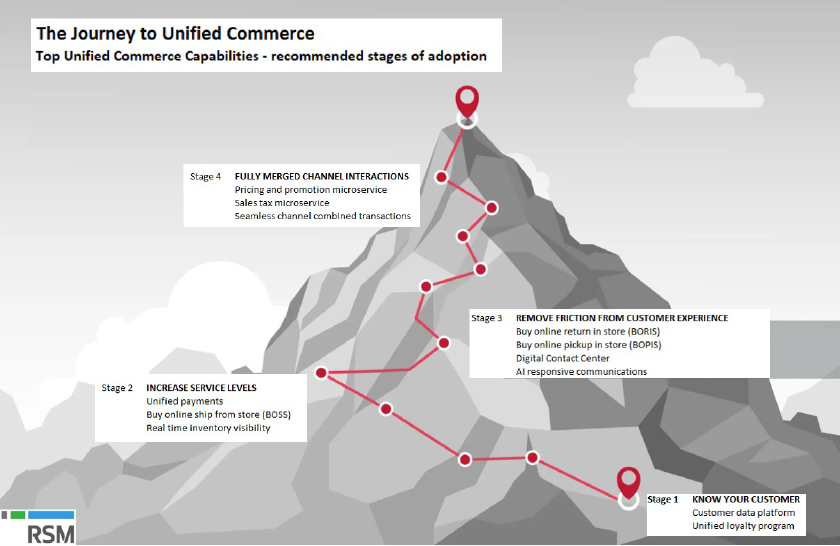The journey to unified commerce is complex and can be daunting, but the benefits are worth the effort
Key takeaways
Begin by building a business case derived from unified commerce capabilities
As you get started, focus on knowing your customer and removing friction from the customer experience
The journey to unified commerce yields higher revenues, more loyal customers, lower inventory costs, better service levels and an enhanced ability to compete against larger, well-funded competitors. While the capabilities required for unified commerce are numerous and sometimes complex, taking a thoughtful approach will help your company achieve success and build momentum for larger efforts. Any company contemplating a unified commerce journey or that may have started one and lost its way can benefit from establishing the desired benefits and then linking those benefits to business objectives and capabilities.
Identifying your company’s priorities
There are many different approaches to unified commerce, but the first step is reviewing and understanding your company’s situation and identifying where it would benefit most. We have developed both a roadmap and a ROI calculator for you to use as a framework for establishing your priorities. Connect with our team if you would like to discuss this framework and how to use it, or if you need help with establishing a custom roadmap for your business.
Here are two places where we often recommend companies start

Starting point No. 1: Know your customer
One of the key capabilities for unified commerce is “knowing your customer” (stage 1 in the above graphic). Many companies have a trove of customer information but have not yet established an understanding of their customers. This would include segmentation, lifetime value, acquisition costs, churn and scoring. Understanding customer acquisition costs and lifetime value may justify investments in customer experience and customer service. This is especially true if a company is not operating at best-in-class levels for these metrics.
A customer data platform can help with this. However, it is important to understand what business benefits would be achieved with a customer data platform and what would need to be done to operationalize these benefits so you can scale them and have a material impact. After establishing a baseline, you can then make changes and re-measure to determine the impact. This can take time and should be scoped in a way that is manageable. One way to get started is with a proof of concept. For example, RSM offers a proof-of-concept project that allows a company to baseline their operations; we then provide guidance on how to influence the outcome for your next measurement
Starting point No. 2: Removing friction
One of the core objectives for unified commerce is improving the customer experience by removing friction (stage 3 in the above graphic). In our roadmap we outline a few capabilities that are likely easier to start with; the first one is an inventory availability micro-service. A service such as this provides customers with inventory information online that increases their willingness to go to a physical store. Stockouts or long shipping times frequently result in a lost sale online but showing that inventory is available in a nearby store can save this kind of sale.
Another way to reduce friction for customers during their online buying journey is by adding a chat capability to your company’s website. Many studies have shown that offering chat can significantly improve conversion rates. Your company should also consider adding other communication channels such as Facebook Messenger and SMS text to further reduce friction.
What happens next?
The journey to achieving unified commerce can be thought of as establishing a collection of capabilities that all lead toward a common goal. Not all of these capabilities require a large investment and many of them can be achieved in stages. We encourage you to start your journey or revisit one you have already started.
Identifying and establishing your company’s unique starting place to begin your unified commerce journey can be complicated. RSM is here to help.

